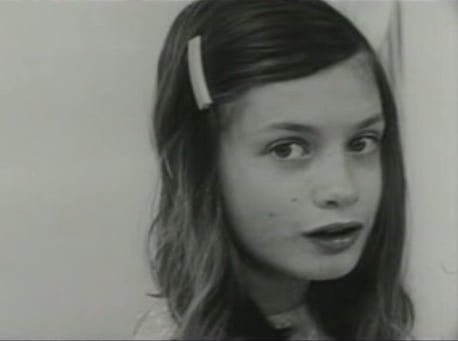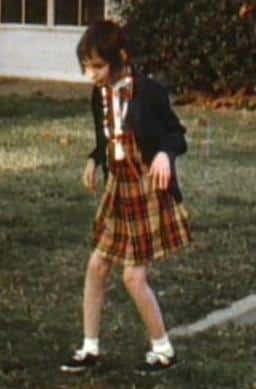
Genie is the pseudonym of an American feral child who suffered severe neglect, social isolation, and terrible abuse.
Feral children are children who have grown up with minimal human contact or even none at all. Besides children being raised in the “natural state” provided by the wild, there are also cases of children raised or kept in extreme isolation. Here is Genie’s story.
Abused, neglected, restrained
Genie was found in California in 1970. She was thirteen when she came to the attention of authorities.
From the age of twenty months, she had been kept in a small room in her parents’ house. She had never been out of the room; she was kept naked and restrained to a kind of potty chair by a harness her father had designed. She could move only her hands and feet.
Genie’s psychotic father, who hated children, forbade her almost blind mother to speak to the child. (He had put another child, born earlier, in the garage to avoid hearing her cry, and she died of pneumonia at two months of age.)
Genie was fed only milk and baby food during her thirteen years. Her father, or when coerced, her brother, spooned food into her mouth as quickly as possible, and if she choked or could not swallow fast enough, the person feeding her rubbed her face in her food.
Genie’s mother claimed her husband fed Genie three times a day but also said that she sometimes risked a beating by making noise when hungry. Genie’s father had an extremely low tolerance for noise, to the point of refusing to have a television or radio in the house. He seldom allowed his wife or son to talk and viciously beat them if they did so without permission, particularly forbidding them to speak to or around Genie.
Genie rescued
In October 1970, when Genie was approximately 13 years and 6 months old, her parents had a violent argument in which her mother threatened to walk out if she could not call her own parents. Her husband eventually relented, and later that day, she left with Genie when he was out of the house to go to her parents’ house. Genie’s brother, by then 18, had already run away from home and was living with friends.
Around three weeks later, on November 4, their mother decided to apply for disability benefits for blind people in nearby Temple City, California. She brought Genie with her, but because of her near blindness, she accidentally entered the general social services office next door.
The social worker who greeted them instantly sensed something was wrong when she saw Genie. She was shocked to learn her actual age, having estimated from her appearance and demeanor that she was around six or seven and possibly autistic. After she and her supervisor had questioned Genie’s mother, they contacted the police. Her parents were arrested, and Genie became a ward of the court.
When Genie was found, she weighed only 59 pounds. She could not straighten her arms or legs. She did not know how to chew. She could not control her bladder or bowels. She could not recognize words or speak at all.
According to the mother’s report — the father killed himself soon after Genie was discovered — Genie appeared to have been a normal baby.
Admitted to a hospital

Genie was admitted to the Children’s Hospital Los Angeles. David Rigler, a therapist and University of Southern California psychology professor who was the chief psychologist at the hospital, and Howard Hansen, then the head of the psychiatry division and an early expert on child abuse, took control of Genie’s care. The following day they assigned physician James Kent, another early advocate for child abuse awareness, to conduct Genie’s first examinations.
The restraining harness her father used had caused a thick callus and heavy black bruising on her buttocks, which took several weeks to heal. A series of X-rays found that she had moderate coxa valga (a deformity) in both hips and an undersized ribcage, and her bone age was that of an 11-year-old.
Despite early tests confirming she had normal vision in both eyes, she could not focus them on anything more than 10 feet away, corresponding to the dimensions of the room her father kept her in.
Learning to speak and draw
Over the next few years, Genie had plenty of interactions with the world and training and testing by psychologists. She gained some language comprehension and learned to speak at about the level of a 2- or 3-year-old: “want milk,” “two hand.”
Her first breakthrough came during a session with language teacher Jean Butler. Jean said to Genie, “You [tie your shoe], and then we can tell Doctor Kent what you can do.” Although difficult to understand, Genie repeated the word “doctor.” She knew more than 100 words by that spring.
Genie learned to use tools, draw, and connect cause and effect in some situations. And she could get from one place to another — to the candy counter in the supermarket, for example — proving that she could construct mental maps of space.
Custody disputes
Unfortunately, Genie’s living arrangements became the subject of rancorous debate. In June 1971, she left the Children’s Hospital Los Angeles to live with her teacher, Jean Butler.
A month and a half later, authorities placed Genie with the scientist’s family heading the research team, David Rigler, with whom she lived for almost four years. Rigler’s wife, Marylin, became Genie’s new teacher.
Marilyn taught Genie how to express her anger outwardly, how to scream and have a fit. Eventually, Genie could even use words to express her emotions. She would say, “rough time.”
Unfortunately, the National Institute of Mental Health revoked funding for Genie’s treatment and research in the fall of 1974. Because of the blurred lines between the foster family and the research team, no one could produce well-kept records or steadfast findings. Alleging the research damaged her recovery, Genie’s mother sued the team and hospital for excessive testing.
Soon after turning 18, Genie returned to live with her mother, who decided after a few months that she could not adequately care for her.
More abuse suffered
Authorities then moved Genie into the first of what would become a series of institutions and foster homes for disabled adults, and the people running it cut her off from almost everyone she knew. They subjected her to extreme physical and emotional abuse. As a result, her physical and mental health severely deteriorated, and her newly acquired language and behavioral skills rapidly regressed.
Genie’s IQ score on nonverbal tests was a low-normal 74 in 1977. Her language did not develop further, and she made language errors that even typical 2-year-olds never make.
In early January 1978, Genie’s mother abruptly forbade all scientific observations and testing of her. Little is known about her circumstances since then. Her current whereabouts are uncertain, although as of 2016, she was believed to be living in the care of the state of California.
More stories of feral children
There are many other stories of feral children in the literature, among others, the story of a boy who lived in Syria, who ate grass and could leap like an antelope, as well as of a girl who lived in the forests in Indonesia for six years after she had fallen into the river. She walked like an ape, and her teeth were as sharp as a razor.
Edublox offers cognitive training and live online tutoring to students with dyslexia, dysgraphia, dyscalculia, and other learning disabilities. Our students are in the United States, Canada, Australia, and elsewhere. Book a free consultation to discuss your child’s learning needs.

